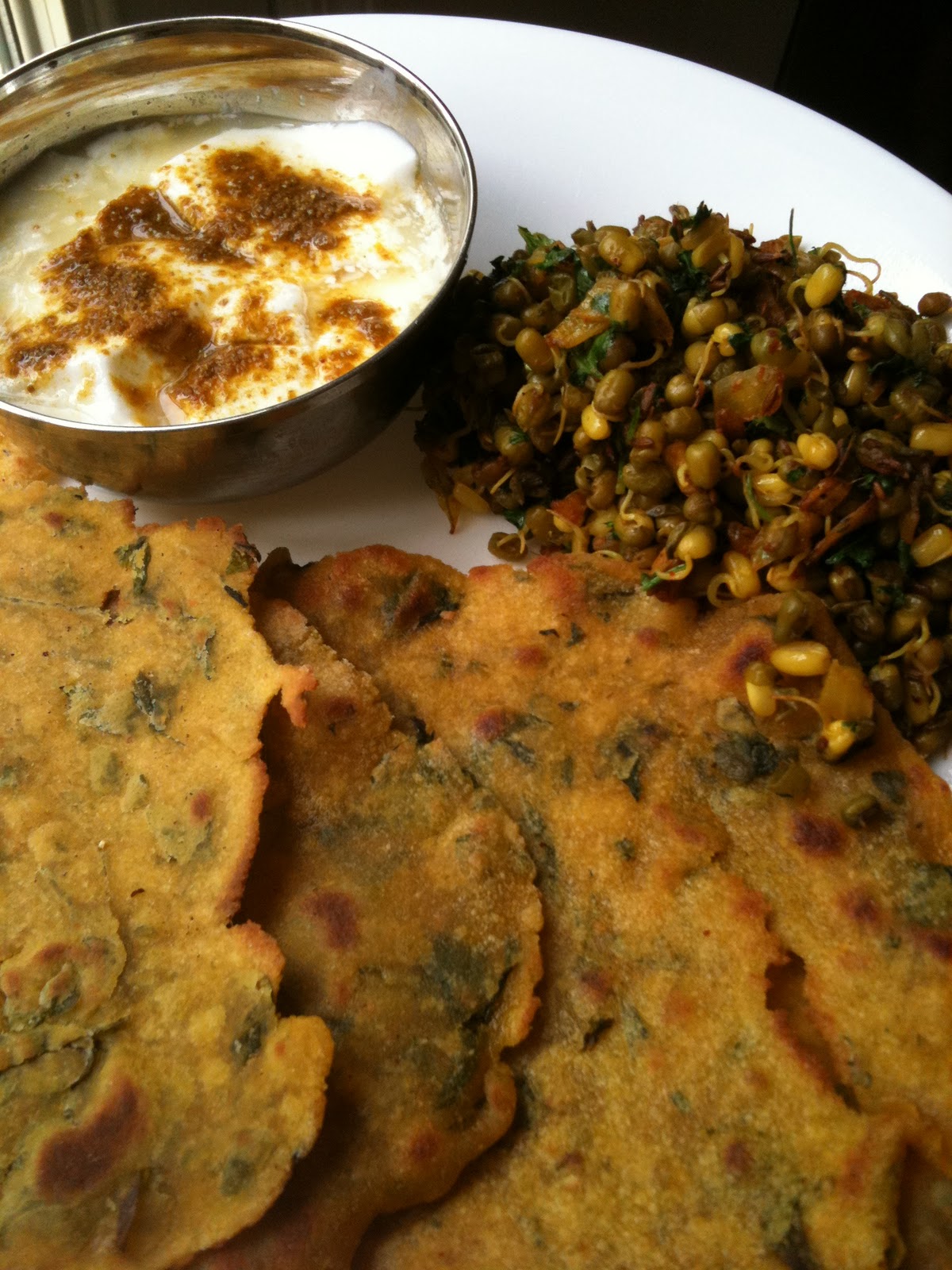
What you see is lunch from a few months back, maybe even last year.
Paraanthas made of cornflour, whole wheat flour and methi leaves, a sabzi containing sprouted moong, chopped tomatoes and onions, garnished with coriander/cilantro leaves, a bowl of homemade yogurt garnished with a spice mix.
I used the Kitchen-Aid to make the dough for the paraanthas.
Just threw in corn flour, whole wheat flour and fresh methi leaves. Sesame oil (my oft-used cooking medium), some salt, a smidgen of red chilli powder (or more?), some garam masala. Add water and run the mixer until you get a dough that’s soft and pliable. Roll into rounds, put on a warm pan, add some ghee, flip it a couple of times, until nice and brown and cooked. YUM.
I sprout moong a lot during summer. I tried doing it this winter and it was a bad bad bad idea. Firstly, sprouting is tough due to the low temperatures. Secondly, sprouts are not the best thing to eat during winter simply because they generate vata (unless well-cooked) and winter is a vata-aggravating season anyway. You are far better off eating vata-pacifying and grounding foods this time of the year. I am no Ayurveda expert but a HUGE enthusiast. There are many wonderful books out there that can give you more information about this amazing science of health.
How to sprout moong?
Take a cup of whole green moong seeds. Rinse with water thoroughly.
Cover with filtered water making sure that all seeds are completely submerged and there is a couple of inches of water above them. This is important because the seeds absorb the water and expand in size. So you want to have extra water in the bowl.
Check the seeds after a few hours (you can leave them overnight too).
Drain out the excess water, if any. Take a clean handkerchief, wet it with water, wring it out, wrap the soaked seeds in the wet cloth and place back in the bowl. Check back in a few hours.
Wet the cloth again, wring it out, wrap the seeds again, repeat. In a couple of days, you will see tiny shoots sprouting through.
You can repeat the process until the sprouts are nice and long. Now take them out and store in an airtight container in the refrigerator. You can add them to salads, sabzis, even pulaos/pilafs and biryanis. I must mention, in this above mentioned sabzi, I don’t toss in the sprouts as is. I steam them beforehand so that they’re easier to digest.
How to make home made yogurt? In another post.
Nupur says:
The parathas are oh so good- you have me craving some right away!
February 6, 2011 — 11:32 pm
Lakshmi says:
Hey Nupur, thanks for stopping by! These paraanthas seem like a dream even to me – been a while since I made these.
February 8, 2011 — 5:56 pm
Geetu says:
Hmm…Makki di rotis ! You should’ve made sarson ka saag with it ! Isn’t it difficult to roll out these parathas ?
August 10, 2011 — 9:32 pm
Lakshmi says:
I have no idea where to get sarson from! It’s a little difficult to roll these out, yes. Been so long since I made these… sigh.
August 10, 2011 — 9:41 pm
Devi says:
Nice…I did however struggle to know what is meant by ‘vata’. Different websites have different meanings, maybe you can do a feature on ‘vata’ ‘pitta’ and ‘kapha’ and foods that promote/decrease these? Or…maybe you already have it in your blog and i am bad at searching it out 🙂
September 7, 2011 — 1:53 pm
Lakshmi says:
Vata is a specific body/constitution type, as defined in Ayurveda. Certain foods can aggravate the vata tendencies. There is tons of info available online, so you should be able to find out more. I am no expert, Devi… although I wish I was!
Thanks for visiting my little place on the Internet… 🙂
Lakshmi
September 7, 2011 — 8:16 pm